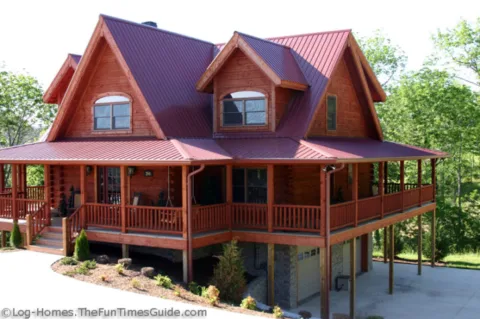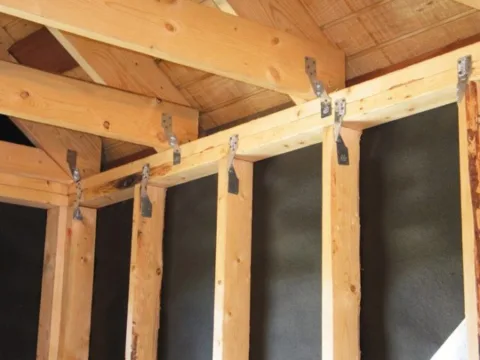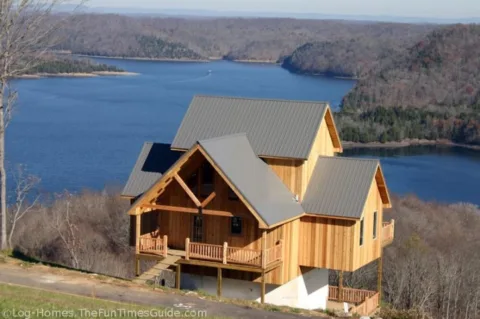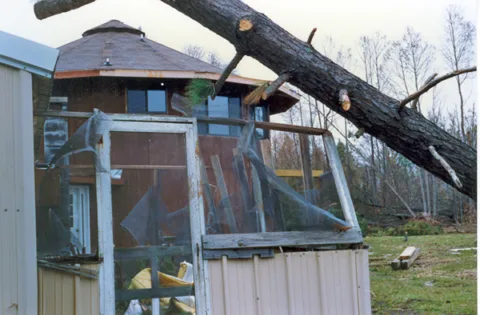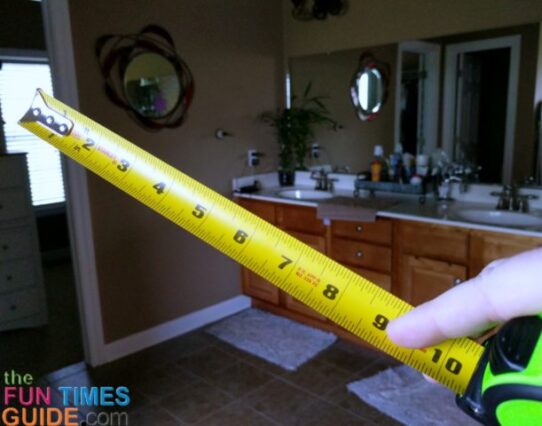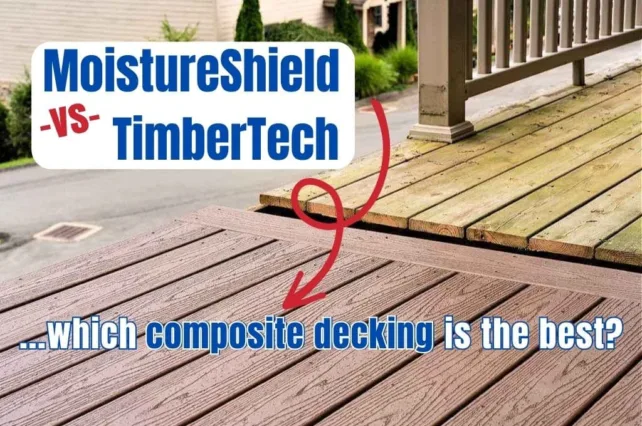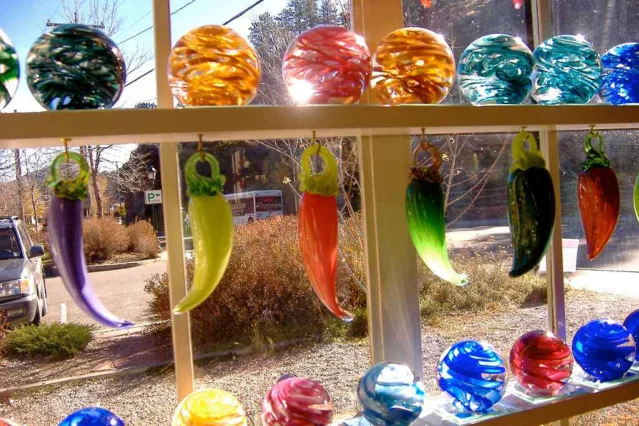A few years ago, I saved this statement that I found in a magazine or online:
Log homes are stronger & sturdier and more likely to survive tornadoes & hurricanes, largely due to all of the inner-locking joints.
Unfortunately… I didn’t write down the source. (It was long before I had this website.) So, I recently decided to do a little research in hopes of determining a log home’s ability to withstand hurricanes and tornadoes.
On websites discussing common log home myths, I found this…
Log homes are stronger than conventional homes. This is almost completely true, because it’s actually the massive log walls that provide strength. Even though other parts of a log home may not be as strong as the walls, the walls tend to hold everything together in times of storms or earthquakes. Source
And this…
Log homes have established a record of surviving other natural disasters in much better condition than frame houses. Ripped from their foundations by flood waters, they’ve been known to simply float intact down the river. During Hurricane Hugo, a log home was the only Carolina beachfront home to remain standing. Florida log homes survived the destructive winds of Hurricane Andrew in 1992 with only minor damage, and in areas of utter devastation during recent California earthquakes, log homes were among the few dwellings that escaped major damage. Source
With hurricane season upon us (June 1 through November 30), I thought it might be worthwhile to see how well log homes fare under typical hurricane conditions.
According to Matt Dobson with the National Association of Home Builders (NAHB), log homes do offer greater protection from the elements and natural disasters.
Dobson says these structures are typically over-engineered and better capable of withstanding natural disasters. He believes that with proper maintenance and treatment, log homes last longer than conventional homes. Source
Examples Of Log Homes Surviving Hurricane Force Winds
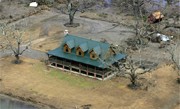
![]() This log home built by Heritage Log Homes withstood 120 mph winds and a 15-foot storm surge during Hurricane Rita.
This log home built by Heritage Log Homes withstood 120 mph winds and a 15-foot storm surge during Hurricane Rita.
![]() Here are more post-hurricane facts about this same log home.
Here are more post-hurricane facts about this same log home.
![]() Watch this video to see a log home with hurricane resistant elements being built.
Watch this video to see a log home with hurricane resistant elements being built.
From the Strongwood Log Home Company:
What, if anything, can be done to build houses that better weather powerful storms? The housing industry thinks it has an answer in systems-built houses. Though log cabins suggest pioneer days rather than cutting-edge technology, they have stood the test of time and have survived severe storms because of their strength and weight. A log house in Santa Rosa Beach, Florida, suffered no damage when Hurricane Ivan swept through with winds of more than 100 mph. Besides the strength of the solid log walls, it was had hurricane straps connecting the timber roof to the log walls.
A few years ago, Southland Log Homes developed tailored log home packages for hurricane-damaged regions in Florida. Here’s an update:
Good News for Florida! Hurricane-resistant log homes withstood Florida’s most recent hurricanes and had also withstood Hurricane Andrew (category 5) some years ago. Learn how “kiln-dried” logs made all the difference for folks living in their log home. Source
The folks at Hunter Mountain Custom Log Homes offer these examples as reasons to build a log home over a conventional stick-built home.
Log homes offer amazing protection from natural disasters, as seen by these 7 unique log home owner experiences:
- A 3,452-square-foot log home in Deltaville, Virginia withstood a 110 mph tornado that devastated the surrounding community.
- Log homes survived Hurricane Hugo and California’s Lomo Prieta earthquake.
- A log home in Carolina was the only beachfront home to remain standing during Hurricane Hugo.
- Florida log homes survived the severe winds of Hurricane Andrew in 1992.
- A log home in Gulfport Mississippi survived Hurricane Katrina in 2005.
- In 1973 a log home survived a flood in Vermont by floating down the river after its foundation had been undercut by flood waters.
- A log home survived winds of 106 mph during Hurricane Ike in Florida.
What You Can Do…
The following tips are from Kim Elmore, a research meteorologist who specializes in severe weather. He put these tips to good use when he built his second log home.
To ensure that your log home will be best equipped to survive whatever Mother Nature sends your way, here are some of Kim’s suggestions:
In severe wind storms, the roof is usually separated from the walls, at which point the walls fail and the entire structure collapses. Log homes have self-supporting walls and so will probably remain intact should the roof be separated from the walls. However, there are things that every log home owner should do if they live anyplace where high winds might occur in severe weather. While your home is very unlikely to suffer a tornadic onslaught, it is likely to endure winds of up to 100 mph anywhere that thunderstorms occur. Source
- Maintain a continuous load path from the roof joists/trusses/rafters all the way to the ground. And make sure that it terminates in something (like a stem wall) that will not be pulled out of the ground.
- Keep in mind that the forces involved will tend to lift the roof, so you must use a method that will not fail under tension.
- Nails and screws must not be prone to pull out:
- Make sure your outbuildings are as wind-resistant as possible.
- Large garage doors, such as those used for single-door two-car garages, are particularly vulnerable. In addition to the door itself failing, the rails on which it runs are also subject to failure: these must be reinforced with wind survivability in mind. Single doors have twice the fastening to the structure and are far less likely to buckle.
- Avoid exposing any particularly vulnerable structural components (garage doors and large windows) toward the direction of the winds. For example, in most of North America, strong straight-line (non-tornadic) winds will typically have a south-westerly to westerly component. If you live on the coast, hurricane winds are always in the onshore flow.
- Trees will indeed lessen the damage wind can do to your home, as long as you are well within the trees. They may fall on your home, but they will also significantly lessen the strength of even tornadic winds and so protect you and your home to some extent.
Read Kim Elmore’s excellent article for full details and photographs. Remember, he is speaking from experience — having lived in two different log homes (after specifically designing one of them to withstand severe weather) and having an extensive background in severe weather research!
Pole Houses
Pole Houses (sometimes called stilt houses) are another unique option for people who are interested in log homes that will withstand whatever Mother Nature sends your way.
Pole houses are specially tailored to your area’s unique climate.
The best part: Pole houses are designed and engineered on a modular grid system which lends itself to the efficiencies of post and beam and timber frame construction techniques which they utilize. Due to the notched and through bolted interlocking system, exposed structural elements move together as a unit and are better able to resist the adverse effects of hurricanes, typhoons, earthquakes and flooding.
A pole house is one of the strongest structures you can economically build which is hurricane, earthquake and flood “resistant.” We strive to engineer structures which will be “survivable” in the case of a natural disaster. Our pole houses have withstood hurricane force winds (in excess of 125 mph), localized flooding and strong earthquakes of 6.0 and 6.7 magnitude.” Source
Deltec Round Homes
Then there are the Deltec homes…
We first started advertising in log home magazines, which have the same kind of audience we were targeting. One factor that may persuade someone initially interested in a log cabin design to go circular is the greater energy efficiency of the design. — Joseph Schlenk, Deltec
Check out the Waterford floorplan by Deltec.
Deltec homes have a reputation for escaping hurricane damage — particularly in Florida, Alabama and the Bahamas.
Here’s proof… check out these photos of Deltec homes that are still standing, next to hurricane-damaged homes: Deltec Homes Hurricane Photo Gallery. (And, don’t miss the Deltec Homes hurricane video gallery, too.)
We’ve gone through the entire process of designing and planning every single detail of our dream log home! We have the blueprints… and the land… and the contractor… and the goal for our log cabin home to be our retirement home. Before you build (or buy) a log home, I have a slew of helpful tips for you — to plan, design, build, decorate, and maintain your very own rustic modern log home. When I’m not fine-tuning the log home of my dreams, you’ll find me at the corner of Good News & Fun Times as publisher of The Fun Times Guide (32 fun & helpful websites). To date, I’ve written nearly 300 articles for current and future log home owners on this site! Many of them have over 50K shares.

